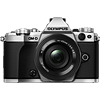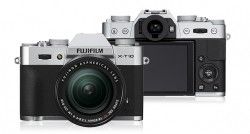Main
Model
Price
Advantages
launch
Announced
Body type
Camera subcategory
Sensor
Effective pixels
Max resolution
Sensor size
Sensor type
Processor
Image ratio w:h
Sensor photo detectors
Image
ISO
Boosted ISO (minimum)
White balance presets
Custom white balance
Image stabilization
Image stabilization notes
Uncompressed format
JPEG quality levels
Boosted ISO (maximum)
Photography features
Minimum shutter speed
Maximum shutter speed
Maximum shutter speed (electronic)
Aperture priority
Shutter priority
Manual exposure mode
Subject / scene modes
Built-in flash
External flash
Flash modes
Continuous drive
Self-timer
Metering modes
Exposure compensation
AE Bracketing
WB Bracketing
Flash range
Screen / viewfinder
Articulated LCD
Screen size
Screen dots
Touch screen
Screen type
Live view
Viewfinder type
Viewfinder coverage
Viewfinder magnification
Viewfinder resolution
Videography features
Resolutions
File Format
Videography notes
Microphone
Speaker
Optics & Focus
Autofocus
Manual focus
Number of focus points
Lens mount
Focal length multiplier
Physical
Weight (inc. batteries)
Dimensions
Environmentally sealed
Battery
Battery details
Battery Life (CIPA)
Storage
Storage types
Connectivity
USB
HDMI
Microphone port
Headphone port
Wireless
Remote control
Wireless notes
Other features
Orientation sensor
Timelapse recording
GPS
GPS notes
Samples
Videos
Summary
The Fujifilm X-T10 maximum resolution of 4896 x 3264 pixels (16 megapixels) is better than the Olympus OM-D E-M5 II highest resolution of 4608 x 3456 pixels (16 megapixels). The Fujifilm X-T10 is equipped with bigger sensor than the Olympus OM-D E-M5 II: APS-C (23.6 x 15.6 mm) versus Four Thirds (17.3 x 13 mm). This is very important difference between these models because big sensor allows the photographer to capture pictures of the more professional quality. The Fujifilm X-T10 has a wider ISO range of 100-51000 than 200-25600 ISO range of the Olympus OM-D E-M5 II. This ISO numbers let you to capture good quality pictures in more difficult situations. The Fujifilm X-T10 has more presets of white balance - 8. This option gives the photographer more control over colour. The Olympus OM-D E-M5 II offers more focus points than the Fujifilm X-T10: 81 vs 77. More number of focus points means less risk of losing focus lock during tracking a moving object.
The OM-D E-M5 II has articulated LCD that will let the photographer to shoot pictures from any interesting perspective. The Olympus OM-D E-M5 II display is better as it offers more screen dots 1,037,000 in comparison to 920,000 dots of the Fujifilm X-T10 screen. The higher dot count display is better for reviewing images on your camera. The OM-D E-M5 II is equipped with a touch screen. The Olympus OM-D E-M5 II has better lowest (60 seconds) and fastest (1/8000 second) shutter speeds.
The Fujifilm X-T10 is equipped with built-in flash. The Olympus OM-D E-M5 II is weather sealed i.e. the camera has protection from rain, snow, dust and sand. The Fujifilm X-T10 battery life is better than the Olympus OM-D E-M5 II battery life. In accordance with CIPA standards you will be able to capture 350 photos with the X-T10 and only 310 with the OM-D E-M5 II. The X-T10 weighs 381g that is 88g lighter than the weight of the OM-D E-M5 II. The X-T10 can utilize optional accessory GPS devices. Recording GPS data can be useful if you like to travel, to be able to go into the image metadata and find out exactly where an image was taken.
Considering the above differences the OM-D E-M5 II becomes the best buy. Check the list of the best offers on Amazon.


